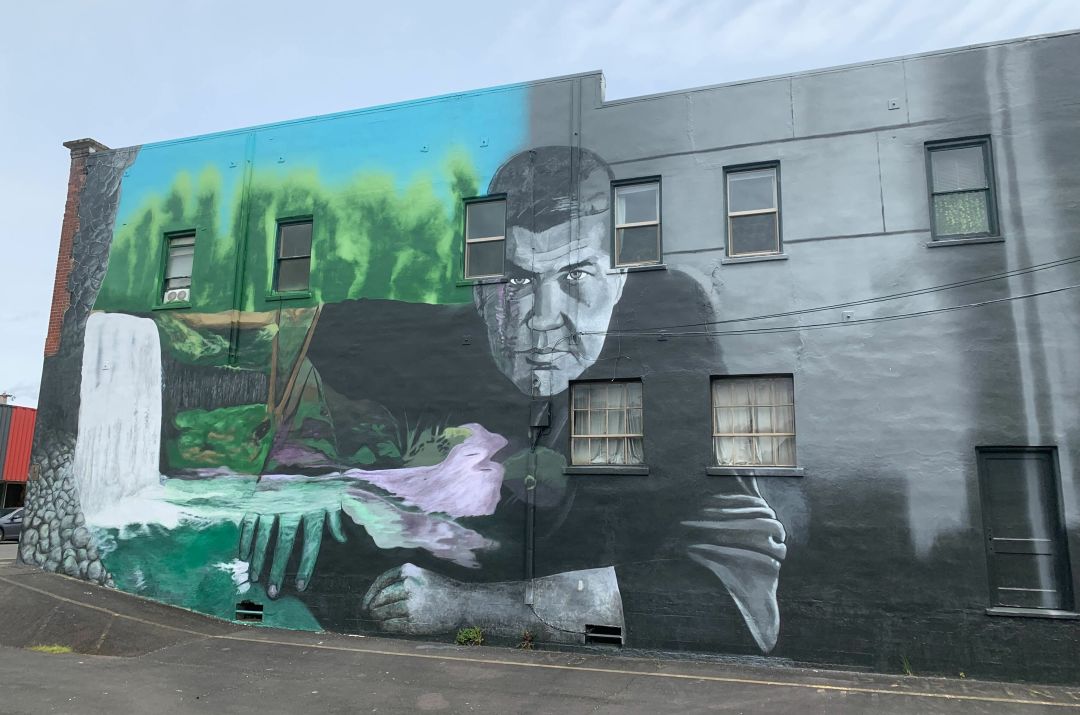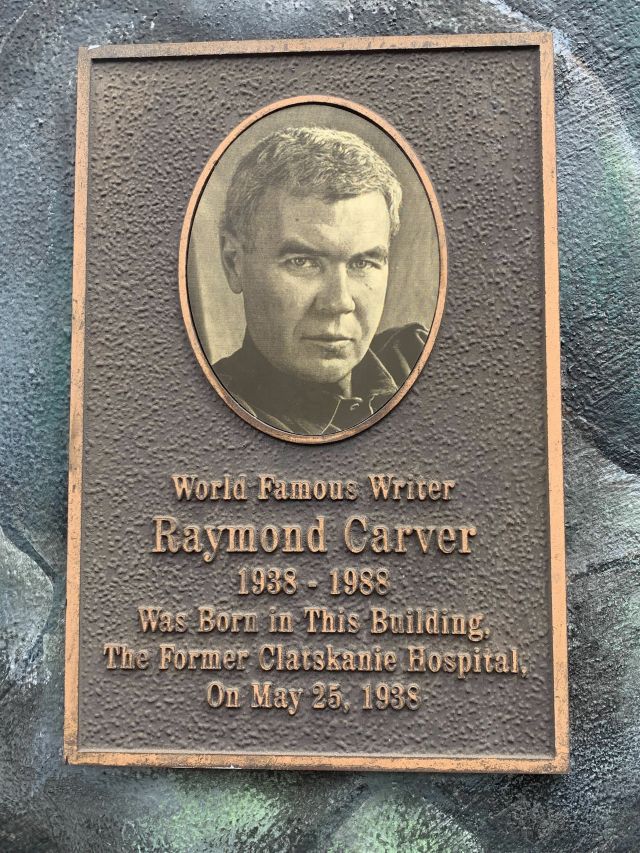New Mural in Clatskanie Celebrates Writer Raymond Carver

The Raymond Carver mural designed by Dylan Eckland, based on a photograph by Marion Ettlinger, on May 13. The trees, waterfall, and hair are still being worked on, and there are lines of text that will be added.
Image: Margaret Seiler
Raymond Carver was born May 25, 1938, in Clatskanie and grew up in Yakima, Washington. The writer and poet—whose short story collections include Will You Please Be Quiet, Please?, What We Talk About When We Talk About Love, and Cathedral, and whose work formed the basis for the films Short Cuts and Birdman—also lived in California, Iowa, and New York. But he may be most associated with Port Angeles, Washington, the hometown of his second wife, the poet Tess Gallagher, and where he lived with her before his death from cancer in 1988 at age 50. The Port Angeles Library has a Raymond Carver Community Room featuring a portrait of the writer hidden in a painting of overlapping fish, and his grave overlooking the Strait of Juan de Fuca sees a steady stream of visitors. His Oregon birthplace has a quiet memorial marker in a park near the library, but now Clatskanie, the mill town on US 30 60 miles northwest of Portland, is also home to a two-and-a-half-story mural of the writer on the side of the building where he was born, a former hospital. Right off the main drag of Nehalem Street, Carver’s face is visible from US 30.

Image: Margaret Seiler
"We wanted to give the 60,000 people that drive through Clatskanie every day a reason to stop and spend some money," says Jeremy Furnish, a member of the Clatskanie Arts Commission and director of the Clatskanie Mural Project. Furnish estimated he and his two fellow painters need another four or five rain-free days to finish the trees, waterfall, and hair, and add text from a Carver poem. The nearly complete project will be a focal point of this weekend's free Raymond Carver Writing Festival in Clatskanie. Friday evening, May 20, features a welcome reception, and on Saturday, May 21, there are lectures, a walking tour, the announcement of winners of a youth poetry contest, and a free screening of Birdman, Alejandro Iñárritu's 2014 film that finds a faded actor trying to stage a Broadway adaptation of a Carver story, at the Birkenfeld Theater.
The mural’s design was selected through a contest last year sponsored by the Clatskanie Arts Commission. The winning design came from Dylan Eckland, a tattoo artist from Seaside who moved to Oklahoma two months ago, so he last saw the mural when it was about 90 percent done. We checked in with Eckland about Carver, Clatskanie, and what it’s like seeing an idea take shape on a grand scale. As told to Margaret Seiler
I entered because my wife saw something about the mural on Facebook. She told me she believed I could be a contender. I was slightly familiar with Raymond Carver’s work but it had been a while since I had read anything by him. I decided to brush up on my reading of his works for inspiration. Some of his work was dark, and I didn't want to depress anyone, so when I read "Where Water Comes Together with Other Water" I knew I could work with it. Especially since the theme of the mural was both Carver and Clatskanie. The quote on the mural [I’ll take all the time I please this afternoon / before leaving my place alongside this river, a part of the mural that has yet to be painted] was pulled from that poem as I thought it went nicely with the theme.
The waterfall used is Beaver Falls, and you can see Carver blending into the falls. This is to impart the idea of his spirit being linked with Clatskanie. The idea that the falls is ever churning and ever new represents the idea that his work is forever being experienced by new audience and new generations. So in that way he is always here.
The photo reference I used was a copyrighted photo Marion Ettlinger took of him. I originally didn't realize this, and after I won I was informed that I needed her permission. I wrote to her apologizing for submitting an entry without first asking permission to use her work. She was kind enough to forgive my ignorance and allow permission.
Originally I had made the sky in the mural purple to represent the darker element of his work. This idea was vetoed by a committee, as they felt they wanted to see something brighter on the mural. Ultimately they wanted a blue sky, and I respect that. The Clatskanie sky is gray much of the time, so if you can add a pop of color here and there, you might as well. Ultimately I think it was a good choice they made. Other than that I was granted creative freedom.
The real credit for the mural, of course, goes to Jeremy Furnish. This project was his brain child, he set up the contest, he organized the painters and did much of the actual painting himself.
Seeing it come to life is amazing. It's something that I designed, that I can take my grandkids to see one day. I've never been a part of something like this. Being chosen gave me a huge confidence boost. Because my occupation is tattoo artist, I am used to the idea of my art being around a long time; I just never thought it would be on such a large scale.
I truly hope people enjoy the mural and say, "Wow, that's cool," when they see it. Maybe they will be inspired to read something by Carver, maybe they will be inspired to write something of their own, maybe someone will decide to do a mural. But most of all I just want people to enjoy it and feel proud to have it as part of the landscape of their town.




